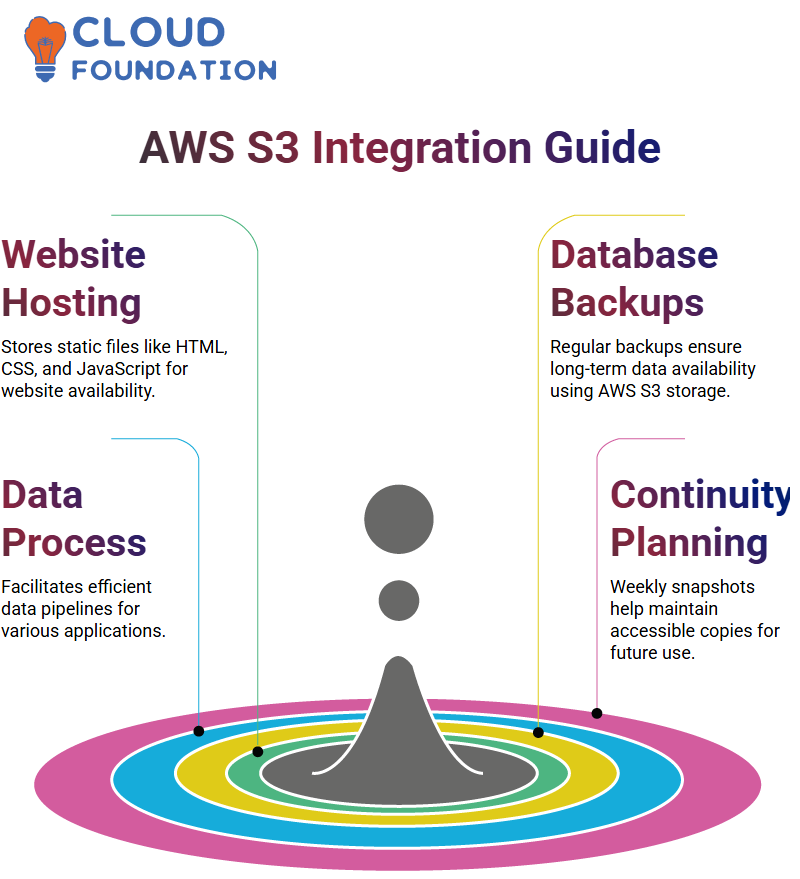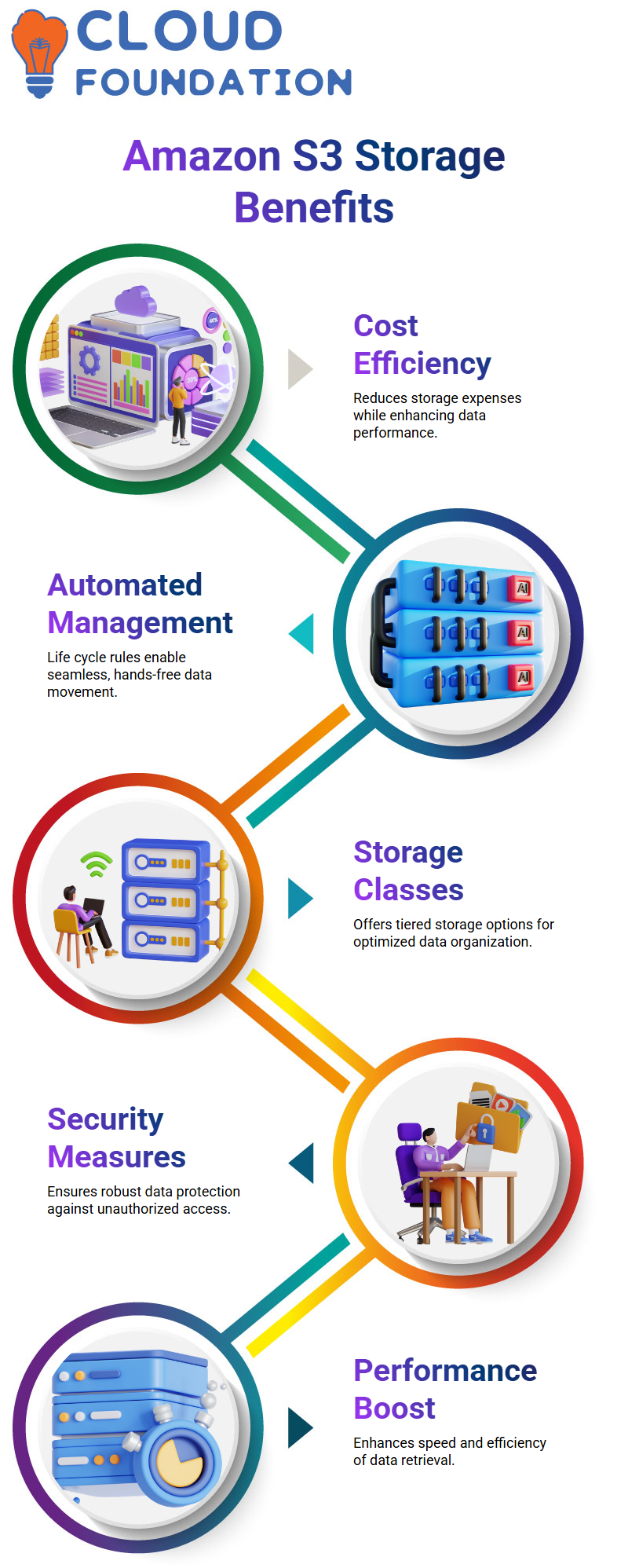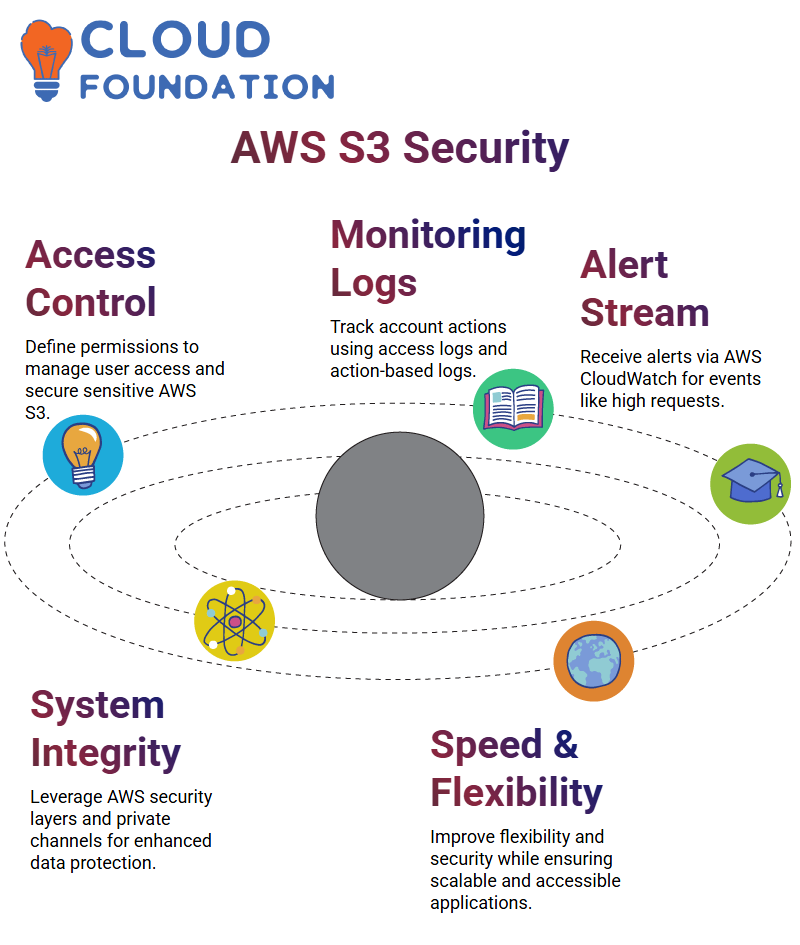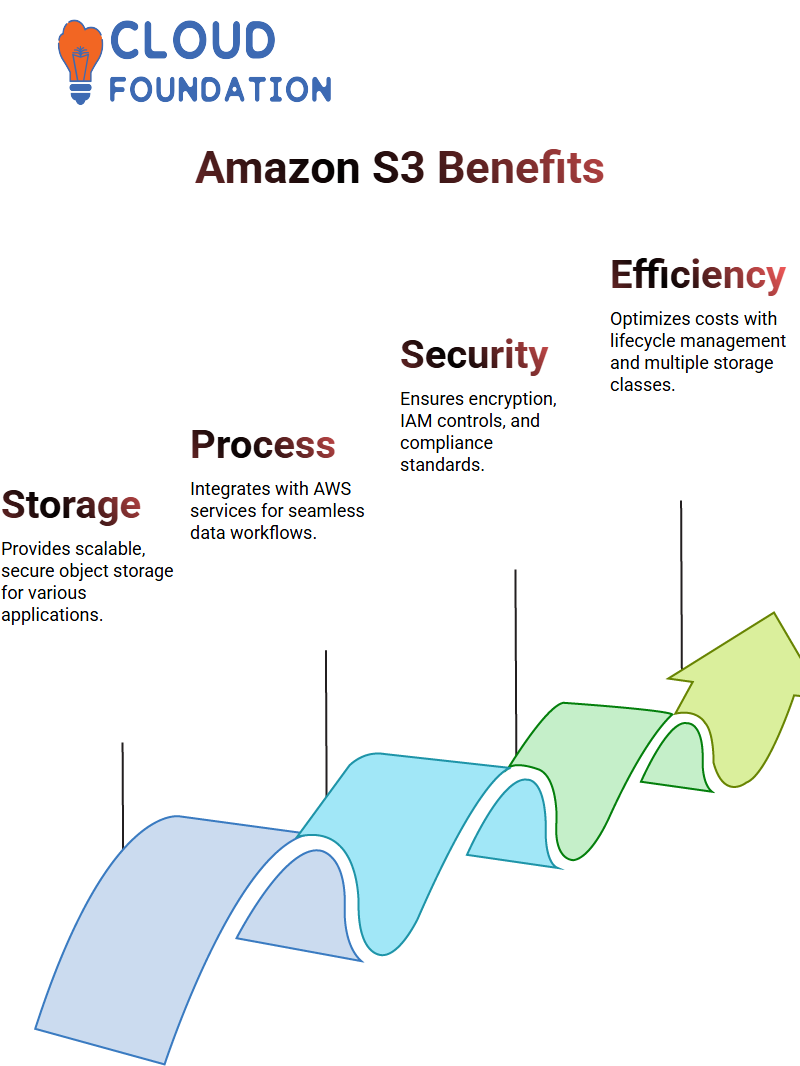AWS S3 Tutorial
Introduction to Amazon S3
Amazon S3 (Simple Storage Service) focuses on object storage using AWS’s cloud infrastructure for general object archiving needs.
It now forms an integral component of their cloud offering as the core functionality for AWS S3.
Users can store any file on AWS S3, from large ones up to 5 terabytes to small files up to 10 terabytes, for diverse uses and applications.
Note, though, that AWS S3 may not suit every application; instead, it best fits certain use cases and requirements.
Amazon S3 Is an Ideal Cloud Storage Solution
AWS S3 provides users with long-term data storage services, making it the go-to cloud service solution for applications storing objects.
Performance characteristics for AWS S3 include being highly scalable to support applications with high throughputs, providing high storage throughput for microservices that need objects stored, and offering low latencies when inserting or retrieving objects from its storage pool.
AWS S3 provides highly available storage services. It will automatically replicate your data across various regions and host it in multiple datacenters.

So even if one region goes offline, data remains accessible via another area, and AWS S3 provides high durability, so there won’t be any worries about data loss.
S3’s integrations with Amazon Web Services (AWS) are among its greatest assets; this allows users to develop sophisticated applications that store data across regions with less risk of data loss.
In addition to offering performance advantages, AWS S3 boasts high availability. Your data will be replicated across datacenters within its region, ensuring that even if one region fails, your information remains accessible from different areas and centers.
Amazon Web Services S3 stands out due to its support for AWS integrations, which enable users to build sophisticated apps that store data across regions.
Integration with AWS is seamless and flexible, enabling users to easily develop complex applications requiring high performance and adaptability.
Integrating Amazon Web Services S3 with Application Architectures and AWS Services
This project uses AWS S3 in multiple application architectures and connects it to numerous AWS services.
Provides specific examples of how AWS S3 can be leveraged across several use cases, such as website hosting, database backups and data processing pipelines.

Website hosting utilises AWS S3 to store static website files such as HTML code, CSS stylesheets, JavaScript, images, etc., for website hosts to use later.
Database backups should be conducted regularly, or once every week, and stored using AWS S3 to allow a copy to remain available over an extended period.
Taking snapshots every week allows users to ensure an accessible copy is stored for continuity purposes.
Understanding AWS S3 Bucket Objects
An object may contain various formats, including JSON files, CSV files, and media content such as videos or images.
Furthermore, valuable SDKs such as Jars or Zips could be stored inside an AWS S3 bucket (similar to folders).
Created using the TLDRe, buckets can be stored by creating a TLDRL structure to store objects that persist through time and are the maximum size of 5 bytes for objects stored therein, providing sufficient capacity to meet most use cases.
Access is managed in two ways: either via URL (HTTP URL) or directly. The first option is S3 Mobile, which provides content retrieval via a text search engine like Yahoo Search (Google App Engine for mobile).
One such object that can be accessed via URL is Amazon (HTTP URL for Amazon), with the object name (fixed and the bucket name (first forward slash) following immediately after.
You can store any string within this bucket, such as s3. Amazon would serve this purpose nicely.
Objects may be stored in buckets like S3, Amazon.com and AWS.com with names matching any string you would like stored there.
Optimising Data Storage with Amazon S3: Benefits, Automation and Security
Amazon S3 provides several advantages for data storage purposes and classes, including reduced costs and enhanced performance.
Among them is the efficiency of storage management, which will significantly lower overall costs while increasing performance levels.
Life cycle rules provide users with an automated data movement process by setting rules about when objects should be uploaded for storage; for instance, an object could be uploaded after 30 days to the standard tier and moved later onto the infrequent access tier after 90 or even longer periods.
Once every 90 days or longer has lapsed, Glacier should be used.
This process is fully automated to make life simpler and cheaper for users; once configured on either the Bucket Level or object Level, it will happen automatically without effort.

Security is of utmost importance with S3, and protecting any information stored there is essential.
Storage classes provide another powerful feature of S3 that simplifies life: users can securely manage and store their data with them, eliminating manual processes while assuring data is kept protected and efficiently stored.
With S3, users can streamline data management and save money by adopting life cycle rules, taking advantage of automation technology, and improving performance. S3 can simplify their lives while minimising manual efforts for maximum efficiency and peace of mind.
Securing Your Content on Amazon S3
Content creation on S3 can be time-consuming and complex, so understanding its security features is vital in protecting its contents.
One feature provided by S3 buckets that helps preserve privacy is their default public access block when created; only account owners can gain entry to the bucket’s content, helping maintain personalisation.
AWS S3 also offers options that make your bucket private, so only account holders may access it.
This practice will protect your content against potential threats. When making your bucket publicly accessible, red text will appear in the console to indicate that anyone outside your organization can access it.
Security can be seen from many perspectives; this summary attempts to cover some key ones. S3 indicates when your bucket may become publicly accessible and should therefore be monitored accordingly.
Understanding these security measures will enable you to develop an efficient workflow when sharing content via S3.
AWS S3 data protection relies heavily on its durability and availability guarantees for optimal functionality, emphasising that data loss will likely never occur; indeed, the standard Tier availability guarantee covers 99.99% offhand!
S3 supports encryption both during transit and at rest, protecting data as it travels across wires to S3 and when stored within buckets in S3.
Data protection options can be configured, while AWS Identity and Access Management (IM) manages resource-specific controls.
IM is an essential service that safeguards AWS resources and S3. Without it, managing AWS resources would become impossible, and vice versa for managing S3 resources.
Manage Access and Security in AWS S3
Amazon Web Services (AWS) offers various security features to safeguard data and resources, such as creating groupings of different users with differing permissions, controlling access to sensitive buckets, or permitting other users to access specific buckets.
Users can set alarms based on the number of get requests they make to specific buckets or objects in AWS Cloud, while monitoring and controlling actions performed on accounts through access logs and action-based logs.

Additionally, AWS Cloud Watch allows users to receive notifications in response to specific events, such as an increase in get requests or invocations.
Finally, AWS Cloud Services provide additional layers of security protection on top of AWS’ cloud infrastructure.
As part of AWS infrastructure, users have access to data centers globally and private back channels connecting data centres that are not publicly exposed.
By using S3, they can utilise AWS infrastructure, providing additional layers of protection.
S3 can help organisations organise extensive data and resources by simplifying data administration and monitoring. Users utilising S3 to effectively oversee their resources ensure that only authorised individuals can access it.
S3 offers more than security; it also boasts improved performance and flexibility features that enable users to scale applications securely while guaranteeing data accessibility.
Automating Workflows with AWS S3 Event Triggers
Events in AWS S3 provide a serverless, elastic, and fully configurable system that integrates seamlessly with AWS S3. Events are valuable for notifications like object creation/modification/deletion/replication, among many others.
AWS S3 events alert users whenever objects are created, modified, deleted, or replicated in AWS S3. Data arriving at an AWS S3 bucket triggers these events, which can be invoked using AWS Lambda functions.
Lambda functions can then use this information in their event to access AWS S3 objects for data processing, aggregation, filtering, or performing other tasks as required.

Your data can then be stored in a database, giving users easy access and manipulation as required. AWS S3’s main feature is its capacity for handling large volumes of information, making it a valuable solution for massive datasets.
Users can efficiently manage their data and ensure smooth operations by taking advantage of events.
AWS S3’s ability to aggregate and filter data allows users to process and analyze it efficiently while also effectively storing it.
Integration of AWS S3 and Lambda for Data Analytics
Amazon Web Services’ S3 and Lambda offer potent solutions for various integrations and tasks, from data ingest pipelines and analysis dashboards to dashboard creation.
This is an example of a customer dashboard using JSON files as tracking elements—monitoring transactions, purchases, refunds, etc.
Analyses of this data aren’t required, but they can still be performed using S3. Indexing can also occur using databases; alternatively, it could be stored separately in another bucket for later purposes.
Storing in databases could prove costly as they require server space, while separate buckets offer greater freedom from disruption than databases may.
Integrating Amazon S3 and AWS Lambda allows for more complex SQL-style queries on data, making it cost-efficient for applications like credit card management systems to store records of purchases, refunds and other transactions.
Incorporating S3 into Lambda allows more complex SQL-style searches on credit card purchases. Purchases, refunds, and other financial activities related to credit cards may all be tracked here.
For instance a credit card app could use these capabilities for tracking information about purchases, refunds and transactions between transactions by credit card application users as part of its data storage needs – such as in keeping records about purchases made against purchases or refunds related transactions related to credit cards issued using credit cards – saving both parties money in terms of storage costs when used cost effectively by Lambda when used together they both allow complex queries on stored information on such as purchases made against credits issued and refunds received against purchases for future reference.
For instance a credit card app could store data regarding purchases made against cards issued for processing purchases by merchants regarding purchases, refunds made against accounts etc; providing information related transactions as needed from within its application database such as purchases/credit/transaction history etc for storage for later reference/transaction history etc for example using it’s API’s server as data stores this.
S3 and AWS Lambda offer seamless integration for various tasks, enabling efficient data management and analysis.
Utilising more flexible resources efficiently reduces the associated costs of traditional databases.
Conclusion
Amazon S3 is one of the cornerstones of the AWS ecosystem. It offers secure object storage that meets various use cases at scale and cost-effectively.

From static website assets storage and real-time analytics support to complex data pipelines and real-time analysis, AWS S3 delivers the flexibility and performance modern applications demand.
Integration between AWS Lambda, Athena, and Kinesis allows serverless data processing, automated workflows, and advanced querying without incurring infrastructure overhead costs.
AWS S3 prioritises data durability and availability to protect and ensure access to content regardless of regional failures. With strong encryption, IAM controls, monitoring tools and comprehensive compliance capabilities that exceed enterprise standards, AWS S3 delivers robust security capabilities suitable for enterprise standards.
Lifecycle management and multiple storage classes enable efficient data storage with minimum costs while maximising efficiency. Amazon S3 empowers users to innovate quickly while managing data with greater control and insight – ideal for backups, big data analytics, media storage or event-driven architectures.
Storage service? No; it’s an all-in-one platform designed for modern cloud data solutions.

Sai Susmitha
Author



